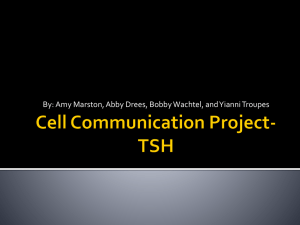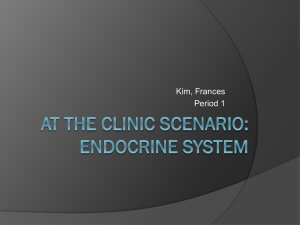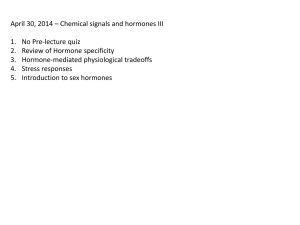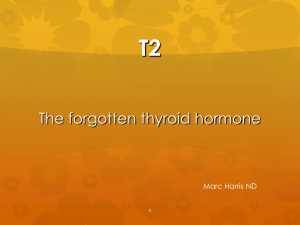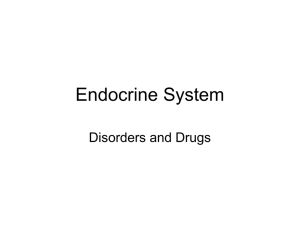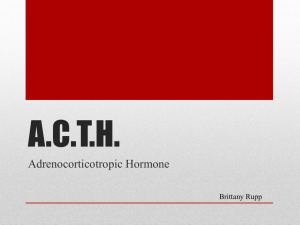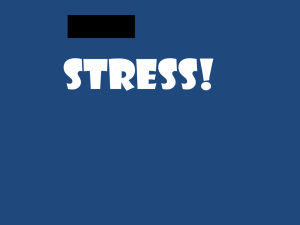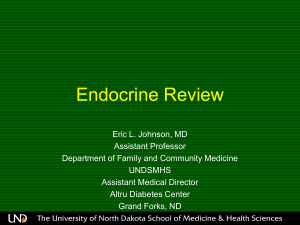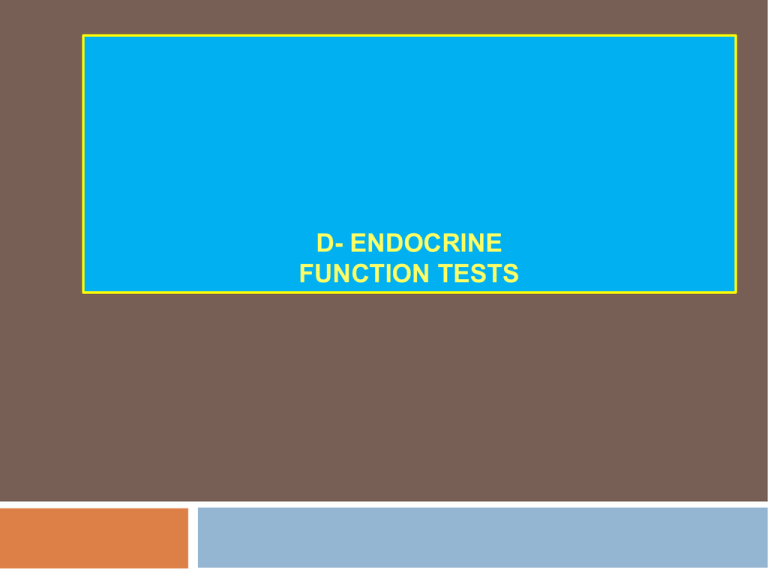
D- ENDOCRINE
FUNCTION TESTS
Objectives
Review hormone regulation in health and
disease
Types of endocrine testing
Basic principles behind test
Considerations in patient preparation and specimen
handling
Interpretion of tests applying acquired knowledge
Endocrine System
Composed of different glands that secrete
hormones directly in the blood
Some hormones are regulatory in nature
Trophic hormones, releasing hormones
Synthesis and secretion of each hormone is under continous feedback
control in normal physiologic conditions
External
stimuli
HYPOTHALAMUS
Fe
ed
ba
ck
Releasing
hormones
PITUITARY GLAND
Trophic hormones
EFFECTOR ORGAN
Diagnosis of Endocrine Disorders
Normally, hormone concentration in circulation
falls within a predictable range
Most hormones are conveniently measured by RIA
or other immunoassays.
Direct measurement of individual hormones in
plasma or serum allows for screening and
establishing diagnosis of most endocrine
disorders.
Determine hyperfunction or hypofunction
Localize the diseased organ
Effector organ (primary)
Pituitary Gland (secondary)
Hypothalamus (tertiary)
Endocrine disorders
1o excess àhigh target organ hormones; low trophic
hormone
1o deficiencyàlow target organ hormone; high trophic
hormone
2o excessà high trophic hormone and hormones of
target gland
2o deficiencyà low trophic hormone and hormones of
the target gland
3o deficiencyà low trophic hormone and hormones of
the target gland
Assessment of
Hormone Function
1. Direct measurement of hormone concentration
A. Basal serum hormone levels
B. Hormone measurement in the urine.
Urinary excretion of hormone or its metabolite
Corrects for fluctuations in blood levels
Integrates value over longer period
2. Dynamic tests
A. Suppressive tests for hormone excess
(DST; Glucose ST)
B. Stimulation test for hormone deficiency (Insulin Induced
Hypoglycemia to evaluate Hypothal-PG axis
3. Image Studies
Hypothalamus
RF
ADH
Thyroid
T4
TSH
Anterior PG
ACTH
Post. PG.
GH
LH
FSH
T3
Oxytocin
Multiple tissues of
the body
PRL
Ad. cortex
Breast
Gonads
Cortisol
Male
testosterone
Female
estrogens/progesterones
HYPOTHALAMIC HORMONES
HORMONE
REGULATION
PHYSIOLOGIC
ACTION
Corticotropin
Releasing H
Negative feedback by ACTH
and adrenal cortisol
Stimulates secretion of
ACTH
Thyrotropin RH
Negative feedback by TSH
and thyroid H
Stimulates secretion of
TSH and prolactin
HORMONE
REGULATION
PHYSIOLOGIC
ACTION
GH Inhibiting H
Positive feedback by
GH
Inhibits secretion of
GH and TSH
Gonadotropin RH
Negative feedback by
FSH and LH
Stimulates secretion
of FSH and LH
Prolactin IH
Positive feedback by
prolactin, TSH, FSH,
LH and GH
Inhibits secretion of
prolactin, TSH, FSH,
LH and GH
Growth H RH
(Somatocrinin)
Negative feedback by
GH
Stimulates secretion
of GH
ANTERIOR PITUITARY HORMONES
Adrenocorticotrophic H (ACTH)
Regulation:
Corticotrophic releasing hormone (CRH) causes secretion in
response to biorhythms with circadian variation
Production is regulated by glucocorticoid concentration via the negative
feedback mechanism
Physiologic action:
Stimulate secretion of adrenocorticoids
Glucocorticoids (cortisol)
Mineralocorticoid (aldosterone)
Androgens)
Causes sedation, increased pain threshold, autonomic regulation
of respiration, BP and HR
Adrenocorticotrophic H ( ACTH )
Episodic secretion in respose to
1. Falling levels of active glucocorticoids
Cortisol ( predominant) 90% inactive bound to
CBG(Cortisol binding globulin)
2. Stress
3. Cycles of sleeping and waking
Display circadian rhythm
Peak: bet 4 am and 8am
nadir: at midnight
Adrenocorticotrophic H
Patient preparation:
Stressful venipuncture inc levels
Specimen collection/handing:
Collected in prechilled plastic tubes with EDTA or
heparin
Place immediately on ice
Store at -20 C within 15 min of collection
TSH or Thyrotropin
Regulation:
TRH from hypothalamus causes secretion in
response to low levels of thyroid hormones (T3, T4)
Physiologic Function:
Stimulates secretion of T3, T4
TSH
Serum TSH is single best screening test for thyroid fxn
followed by FT4
Useful for evaluating both thyroid and pituitary function
Elevated serum level:
sensitive and specific indicator of primary HYPOTHYROIDISM
Normal or decreased level: secondary or tertiary
hypothyroidism
Growth Hormone
AKA : somatotropin
Most abundant hormone of ant PG
Growth Hormone
Regulation:
GHRH and GHIH regulates its secretion in response to
exercise
stress,
hypoglycemia
Amino acids
testosterone
estrogen levels
Physiologic Function:
Promotes growth of soft tissue , cartilage and bone
Stimulates Pr synthesis , fat and CHO metabolism
Growth Hormone
Increase GH à gigantism in children
àacromegaly in adults
Decrease GH in children à dwarfism
Secreted in pulsatile bursts with very
short half life
single random determination ( limited usefulness)
24 hours hormone secretion level (better
measurement)
Growth Hormone
Patient preparation:
Patient should be fasting
Complete rest for 30 min before collection.
Spikes occur 3 hr after meals, stress, or exercise and 90
min after onset of sleep,
Specimen:
Serum preferred; refrigerate immediately; stable at 28C for 8 hr.
Prolactin Hormone
Biochemical properties similar with GH and placental GH
Main target organ: adult female mammary gland
Regulation:
Regulated by TRH, dopamine
Physiologic Function:
Increased in pregnancy, sucking
Initiates lactation ; growth of mammary tissues;
controls osmolality, fat , CHO , Vit D metab and
steroidogenesis in the ovary and testis
Effects :
Suppresses ovulation
Stimulates growth of prostate
Hypersecretion :
Females: hypogonadism , infertility, oligo/amenorrhea
, galactorrhea
Males: inhibits testosterone secretion, decrease
spermatogenesis , infertility and galactorrhea
Prolactin Hormone
Levels fluctuate; fluctuations occur Q 95 min,
Long half life ( approx 50 min )
Physiologically stimulated by :
Pregnancy, breast feeding, sleep, dietary Pr,
hypoglycemia, exercise and stress
Prolactin Hormone
Patient Preparation:
Collect 3-4 hr after awakening;
levels increased during sleep and peak in early
morning.
Avoid emotional stress, exercise, ambulation, protein
ingestion ( can increase levels).
Specimen:
fresh nonhemolyzed serum; stable at 4 C for 24 hr.
Follicle Stimulating and Luteinizining H
Regulated by GnRH from hypothalamus
Controls the functional activity of gonads
Exhibit episodic, circadian and cyclic variations– best to
use serial blood tests or timed urine collection
Specimen:
Serum, plasma and urine acceptable;
Stable 8 days at room temp; two weeks at 4C
HYPOTHALAMIC-PITUITARY FUNCTION
TESTS
Hyperpituitarism
Most are due to benign tumors that are autonomous and
do not respond to negative feedback control
GHsecreted by pituitary adenoma is not suppressed by
glucose
Exception to the rule of suppressibility:
Prolactinoma and Pit adenoma that secrete ACTH(Pituitary
Cushing); both are partially autonomous
GH Excess: Acromegaly
1. Serum GH
Elevated basal or random levels in most acromegalics
Basal and random GH may also be inc in
Normal patients due to episodic secretion
Malnourished patients
Anorexia nervosa
Patients on estrogen therapy
Best test to confirm acromegaly:
Measurement of GH following a glucose load.
GH is normally suppressed to <2ng/ml one hour after a
75 -100g glucose load.
Failure to suppress means a functioning pituitary
adenoma
Pituitary Hyperpituitarism
2. Serum Somatomedin C
Synthesized mainly in the liver
Mediates most of the major growth promoting effects of GH
Involved in negative feedback regulation of Normal GH
secretion
Serum level of SM-C is a good screening test for acromegaly
Basal SM-C is elevated in acromegaly
Maybe elevated in adolescents during the peripubertal growth
spurt and during pregnancy
Hypopituitarism : GH deficiency
GH testing:
Shd be routinely included in evaluating children with short
stature
Not indicated in adults suspected of hypopituitarism
Basal GH levels: not reliable to distinguish deficiency
from normal;
Baseline measurement : fasting morning sample
Factors that increase GH secretion:
Low serum glucose, dopamine, exercise
Laboratory diagnosis : Hypopituatarism :
GH deficiency
Screening tests for GH deficiency:
GH measurement after 15 min exercise
Measurement of somatomedin:
Laron Dwarf: normal GH but low somatomedin
Stimulation Test to confirm GH deficiency
Stimuli
1. Insulin
2. Arginine
3. L-dopa
4. Clonidine
GH should be measured every 30 mins for 2-3 hours
Normal: GH increment above baseline >5ng/ml or a
maximal GH>7ng/ml
GH deficiency: failure to respond to at least two
independent stimuli; hypothalamic or pituitary gland
dysfunction
Stimulation test:
Insulin induced
hypoglycaemia to investigate
suspected GH deficiency.
Insulin decreases plasma
glucose concentrations and in
a normal person this
stimulates the release of GH
(A)
A reduced or absent response is
seen in a GH deficient patient (B)
Stimulation Test to confirm GH deficiency
GH stimulation test (After CRH):
A CRH injection is given followed by measurement of
the blood level
Normal: GH elevated
Hypopituitarism: no response
Hypothalamus
Fe
ed
ba
ck
Bolus injection of releasing hormone
PITUITARY GLAND
Measure Growth Hormone
No response or delayed peak response (60 mins
vs 20 mins)
ADRENAL FUNCTION TESTS
Hormones of Adrenal Gland :
Hormones of adrenal cortex (adrenal corticosteroids) :
Glucocorticoid ( cortisol ) secreted by cells in zona fasciculata –
Mineralocorticoid ( aldosterone ) secreted by cells in z.
glomerulosa Sex hormones (testosterone and estradiol ) secreted by cells in
zona reticularis
Catecholamines (dopamine, epinephrine and NE)
secreted by chromaffin cells of adrenal medulla
Glucocorticoid (Cortisol)
Physiologic action:
Affects metabolism of proteins, CHO and lipids
Stimulates gluconeogenesis by the liver, inhibits the effects of insulin
and decrease the rate of glucose use in the cells
Regulation:
Secreted in response to stress and ACTH
Normally:
secretion higher in early morning (6-8am)
lower in the evening (4-6pm);
lowest at midnight
Cortisol excess (Cushing’s Syndrome and in patients under stress):
loss of diurnal variation in secretion
Circadian rhythm of cortisol secretion
Feedback control of Adrenal Corticosteroid
synthesis and release
Decreased blood levels of adrenal corticosteroids, stress
Hypothalamus secretes corticotrophin
releasing hormone (CRH)
Hormone
secretion
suppressed via
negative
feedback
Ant Pit g gland secretes ACTH
Adrenal cortex secretes hormones
(cortisol)
Corticosteroid Excess : Cushing Syndrome:
Hyperadrenalism with production of excess
cortisol
Clinical Presentation:
1. Glucocorticoid Effects: “cushingoid habitus”,
bone dimineralization, glucose intolerance
2. Mineralocorticoid effects: HPN, edema,
hypokalemic alkalosis
3. Sex steroid effects: hirsutism, acne, amenorrhea,
gynecomastia
Cushing Syndrome: Causes
Exogenous glucocorticoid therapy (most common cause)
Other causes:
1. ACTH Producing pituitary adenoma (60%)
( Cushing disease)
2. Glucocorticoid producing adrenal neoplasm(20%)
(adenoma or carcinoma)
3. Ectopic ACTH-producing neoplasm(20%)
Tests for Adrenal Hormone Function
1. Serum cortisol
-Secretion is episodic and pulsatile in response to ACTH
-Single determination neither specific or sensitive
-90-97% is bound to CBG or transcortin
- Elevated in adrenal hyperfunction (Cushing’s Sx)
- Decreased in adrenal hypofunction (Addison’s)
- Diurnal rhythm of cortisol secretion is lost in Cushing Sx and patients
under stress
2. Urine Free Cortisol (UFC):
**Glucocorticoids:
Degraded in the liver and excreted in the urine as
Hydroxycorticosteroid (17-OHCS).
Urine 17 OHCS is an indirect measurement of
excessive plasma Glucorticosteroid
-indirect measure of the cortisol production rate
-Normal: <90ug/24hr
- UFC> 250mg/24 hr is almost always due to
Cushing Sx
3. Dexamethasone Suppression Test
Dexamethasone:
cortisol analoque that should suppress
ACTH in normal person and reduce cortisol.
Rapid DST for screening (low Dose DST)
Administer 1 mg dexamethasone at 11pm; measure 8am the
following day:
Normal: Suppressed cortisol <5ug/dl
No suppression in Cushing’s Sx: useful for screening
Dexamethasone
Suppression
Test
Normal person: dexamethasone will
suppress ACTH secretion (feedback) and
cortisol production is consequently reduced.
No suppression to low dose:
Cushing Syndrome
Ectopic ACTH Syndrome: no
suppression even to HDST
In pituitary- dependent
Cushings only high doses
may suppress ACTH
secretion
Adrenal Function Test
1. Plasma ACTH level
Increased : pituitary tumors
ectopic ACTH producing tumors
Decreased: cortisol producing tumors in adrenals
exogenous hormones
Adrenal Function Test
2. Overnight HIGH DOSE DST:
Procedure: Administer 8mg at 11pmà measure serum cortisol 8am
before and on the morning following dexamethasone
ACTH producing adenoma : Suppression of cortisol to 50% of
basal
Adrenal neoplasm or ACTH syndrome: No suppression of
cortisol
Primary Adrenal Insufficiency (Addison’s
Disease)
Deficiency of all adrenal steroids
Relatively rare
Results from progressive destruction of
adrenals by local disease or systemic disorder
Adrenal Function Test for Adrenal Insufficiency
3. Metyrapone test
Metapyrone: Blocks 11 beta-hydroxylase in ad. cortex
which reduces synthesis of cortisol hence stimulate
synthesis of ACTH with proximal buildup of deoxycortisol
in adrenal
Procedure:
1. Administer 3.0 mg metyrapone at midnight.
2. Measure cortisol and 11 deoxycortisol at
8am baseline
and post-metyrapone
deoxycortisol
Metapyrone
11-β Hydroxylase
Cortisol
Metapyrone: Blocks 11 beta-hydroxylase in ad. cortex
which reduces synthesis of cortisol hence stimulate
synthesis of ACTH with proximal buildup of deoxycortisol
in adrenal
Metyrapone Test:
Normal response: fall in cortisol to <5ug/dl and increase in
ACTH, 11 deoxycortisol and urinary 17-OHCS
Cushing’s Dse: Increase in 11-deoxycortisol levels
Adrenal tumors/Ectopic ACTH: 11-deoxycortisol fails to
increase
Failure of cortisol to fall invalidates the test
Not routinely used, although maybe better than High dose
DST
Adrenal Function Test
Cortisone Stimulation (Cosyntropin); ACTH
Stimulation
Screening test; less time consuming; can be done on
OPD basis
Cortrosyn (synthetic subunit of ACTH) have full
stimulating effect of ACTH in healthy individuals
-à failure to respond : adrenal insufficiency
Procedure:
1. Get 4ml fasting blood venous sample at 8am
2. Administer cosyntropin IM/IV
3. Get 4ml samples at 30 and 60 mins after
Mineralocorticoid (Aldosterone)
Regulation:
ALDOSTERONE (predominant mineralocorticoid) is secreted by
cells in the zona glomerulosa in response to ANGIOTENSIN
(mainly); and by ACTH (not significant)
Clinical effects
Retains Na and H20 accompanied by K depletion
leads to excess intravascular volumeà HPN
Aldosterone
Elevated levels (primary aldosteronism)
Conn’s disease ( aldosterone producing adenoma)
Elevated levels (secondary aldosteronism) because of
extenal stimuli or greater activity in the RAS:
Salt depletion
Potassium loading
Cardiac Failure
Nephrotic syndrom
Diuretic abuse
Aldosterone
Decreased levels of aldosterone:
Aldosterone deficiency
Addison’s disease
Tests for hyperaldosteronism:
1. Basal level of plasma aldosterone
*limited diagnostic value
2. Urinary Aldosterone
3. Captopril Suppression Test
Angiotensin- converting enzyme inhibitor: decrease the
renin-stimulated aldosterone production secondary
aldosteronism; no response in primary aldosteronism
Test for hyperaldosteronism:
5. Aldosterone Suppression test (Isotonic Saline
infusion)
Normal response à suppress aldosterone release by decreasing
renin
Primary aldosteronism à lack of aldosterone suppression
6. Aldosterone Stimulation Test ( Sodium restricted from diet)
Normal responseà renin level increased
Primary aldosteronismà slight or no response in renin level
Adrenal Insufficiency:
1. Serum cortisol decreased
2. Rapid ACTH stimulation test
3. Long ACTH stimulation test
4. Serum ACTH
Elevated in primary adrenal insufficiency
Decreased in secondary and tertiary
5. Metapyrone test
PHEOCHROMOCYTOMA:
Cathecolamine Excess
1. Increased cathecolamines at all times.
Cathecolamines: either epinephrine or norepinephrine is
increased and should be assayed separately.
Plasma norepinephrine >750pg/ml or
Epinephrine >100pg/ml are found in 90-95% of patients
2. Urine test
Vanyllmandelic acid
Total metanephrine
Fractionated cathecholamines
PHEOCHROMOCYTOMA:
Cathecolamine Excess
3. Clonidine Suppression test:
Clonidine (alpha agonist) à decrease efferent
symphathetic flow
Normal: Norepinephrine level within N range
Pheochromocytoma: exaggerated response
PHEOCHROMOCYTOMA:
Patient Preparation
Blood should be drawn through a previously inserted
catheter from a patient who is fasting, resting quietly
and non-stressed.
If patient is to kept on antiHPN meds during resting
The least interfering agents shld be used:
diuretics.
Vasodilators, and
alpha or Beta adrenergic blockers.
THYROID
DISORDERS
Thyroid function
Hormone Regulation
TRH à TSH
iodine uptake, organification
synthesis & release of thyroid hormone
T4/T3 Regulate:
basal metabolism, thermogenesis, lipogenesis
fetal CNS development
Regulation of thyroid hormone secretion
>99% of thyroid hormones are carried in plasma bound to protein
<1% is free & active
Thyroxin-binding protein (TBG) binds most of the T4 and T3
TBG is synthesed by liver, ∴severe liver disease → ↓TBG → ↓ TT4 due
to ↓ protein-bound T4
↑ Estrogen (ex. Pregnancy) → ↑ synthesis of TBG → ↑ total T4 due to ↑
protein-bound T4
Albumin and pre-albumin also carry T4 and T3 in plasma
Thyroid Hormones
Thyroxine (T4)
Thyroid gland
t1/2: 8 days
Triiodothyronine (T3)
80% in Periphery
Liver/kidney remove iodine from T4
t1/2: 1-1.5 days
Binding Proteins
T4/T3 99% protein bound
Prevents excess tissue uptake
Maintains accessible reserve
T4
Protein* binding
+ 0.03% free T4
Protein* binding
+ 0.3% free T3
80%
T3
20%
(10-20x less than T4)
Total T4 60-155 nM
Total T3 0.7-2.1 nM
T3RU/THBI
0.77-1.23
*TBG
75%
TBPA
15%
Albumin 10%
Thyroid Function Tests :
TSH
T3
T4
FTI ( free thyroxine index ), FT4 ( free
thyroxine )
TRH
TBG ( Thyroid binding globulin )
More T4 in serum (5.5 to 12.5 ug/dl) T3 in
serum 9(100 to 200ng/dl)
T3 exerts the major hormone effects à thus
more phyiologically significant
T4 converted by peripheral nonthyroidal tissues
to T3
T4 may have no direct effect until converted
to T3
THYROID FUNCTION TESTS
THYROID STIMULATING HORMONE (TSH)
Stimulated by TRH (from hypothalamus)
Serum TSH is single best screening test for thyroid fxn
followed by FT4
Useful for evaluating both thyroid and pituitary function
Elevated serum level:
sensitive and specific indicator of primary HYPOTHYROIDISM
Normal or decreased level: secondary or tertiary
hypothyroidism
Clinical Uses of TSH
Screening for euthyroidism
Initial screening and diagnosis for hyperthyroidism
(dec. to undetectable levels except in rare TSHsecreting pituitary adenoma) and hypothyroidism
Useful in early or subclinical hypothyroidism before
the patient develops clinical findings
Clinical uses of TSH
Differentiate primary (increased levels) from
central [pituitary or hypothalamic] hypothyroidism
(decreased levels)
Monitor adequate thyroid hormone replacement
therapy in primary hypothyroidism
TSH increased in :
Primary untreated hypothyroidism
Hypothyroidism receiving insufficient thyroid
hormone replacement therapy
Hashimoto thyroiditis
THYROID FUNCTION TESTS:
Total T4 and T3
1. TOTAL THYROXINE(T4)
ANDTRIIODOTHYRONINE(T3) LEVELS
Total thyroxine (T4) is a good index of thyroid fxn when
TBG are normal
T3 level- in cases of hyperthyroidisn with normal or low T4:
T4; useful in monitoring therapy
THYROID FUNCTION TESTS:
Total Thyroxine ( T4)
High: hyperthyroidism and acute thyroiditis
Low: hypothyroidism and chronic thyroiditis
Affected by concentration of binding proteins
(TBG)
THYROID FUNCTION TESTS:
Total Serum T3 ( Triiodothyronine )
Elevated proportionately to T4 in
hyperthyroidism
Decreased in hypothyroidism
T3 thyrotoxicosis ( 5% of ind.) T3 elevated
while T4 is normal
Not routinely measured except to monitor tx
of T3 thyrotoxicosis
THYROID FUNCTION TESTS:
Thyroxine Binding Globulin
A glycoprotein: synthesized in the liver
Principal serum carrier for T4 ( 75% ) and T3
Less than 1% of T3 and T4 are in the free form which
determines function
Estrogen influences thyroxin binding
Phenytoin, coumarin, heparin clofibrate and aspirin compete
with T3 & T4 for TBG binding sites
Measurement is rarely indicated
T3 Uptake
Indirect measurement of unsaturated TBG in
blood
Determination is expressed in arbitrary terms
is inversely proportional to the TBG
Low T3U is indicative of conditions where there is
elevated levels of TBG uptake
T3 Uptake
Hypothyroidism: insufficient T4 to saturate TBGà
unbound TBG is elevated and T3U values are low
Pregnant patients: TBG are increased
proportionately more than T4 levelsà high levels of
unbound TBG reflected in low T3U values
Useful only when T4 is done
Used to calculate FTI or F7
T3 Uptake
Procedure:
Known amount of radiolabeled T3 is added to test
serum
Available binding sites in test serum combine with
labeled T3 inversely proportional to the amount of
endogenous T4 already bound
Low endogenous T4 (hypothyroid) à many TBG sites free to
react with labeled T3—measured residual radiocativity is low
High endogenous T4 (hyperthyroid) à few TBG sites free to
react with labeled T3à measured residual radioactivity is
high
Resin is used to measure residual radioctivity
Low residual activity—numerous binding sites unoccupied( low
endogenous T4)
High residual activity—few binding sites unoccupied( high
endogenous T4)
Results are expressed as % radioactivity left unbound
Hyperthyroidism: both T4 and T3U high values
Hypothyroidism: both T4 and T3U have low values
THYROID FUNCTION TESTS:
FREE THYROXINE INDEX
Correlates better with clinical status
in the presence of abnormalities in TBG
Calculated as the product of absolute thyroid
hormone and the binding capacity of TBG
FTI= Measured FT4 (T4 x Value of T3 Uptake)
(Reference Interval=1-4.2)
Normal in pregnancy;
low in hypothyroidism;
high in hyperthyroidism
Thyroid Function Tests
Hyperthyroidism
Hypothyroidism
Total T3 & T4 in serum Increased
Decreased
Free thyroxine index
Increased
Decreased
Serum TSH
Decreased
Increased
Interpreting Thyroid
Function Tests
Clinical patterns of
thyroid disease
Hyperthyroidism-
Lab: excessive levels of TH ( T3 , T4 ) ;
S/sx: heat intolerance, palpitation, weight loss,
tachycardia tremors
Causes: Graves Ds, toxic adenoma, toxic goiter ,
TSH secreting pituitary adenoma
Hypothyroidism –
Lab: decrease levels of TH
S/sx: Bradycardia, cold sensitivity, dry skin,
muscle weakness , myxedema, cretinism
Causes : TG ablation and destruction ( primary
) ; pituitary hypofuncytion of TSH (secondary )
Laboratory Diagnosis of Thyroid Disease
1° thyroid dis. is abnormality in the thyroid gland
TRH and TSH level just reflect N feedback response
2° thyroid dis. is really an abnormality in pituitary gland which cause error in
amount of TSH produced
T4 and T3 conc’n just reflect N feedback response
3° thyroid dis. is abnormality in hypothalamus causing error of TRH
produced
Both TSH and T4 & T3 levels just reflect N feedback response
Measuring trophic hormones and hormones of the
peripheral endocrine gland
High TSH - Low T3/T4
1o
Hypothyroidism
Low TSH - High T3/T4
1o
Hyperthyroidism
Low TSH - Low T3/T4
2o
Hypothyroidism
“Euthyroid Sick Syndrome”
Severe illness often results in low serum levels of
T3 and T4
Causes:
1. Decreased in serum pre albumin in severe illnessà
decrease in hormone binding capacity
2. Fall in amount of T4 deiodinatd to T3 with increase in
the metabolic pathways leadig to the inactive product
reverse T3
Diagnosis: demonstrating normal TSH level.

